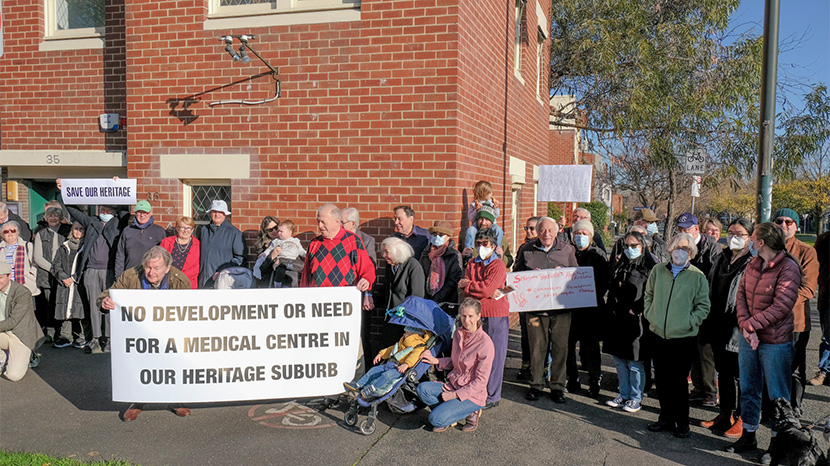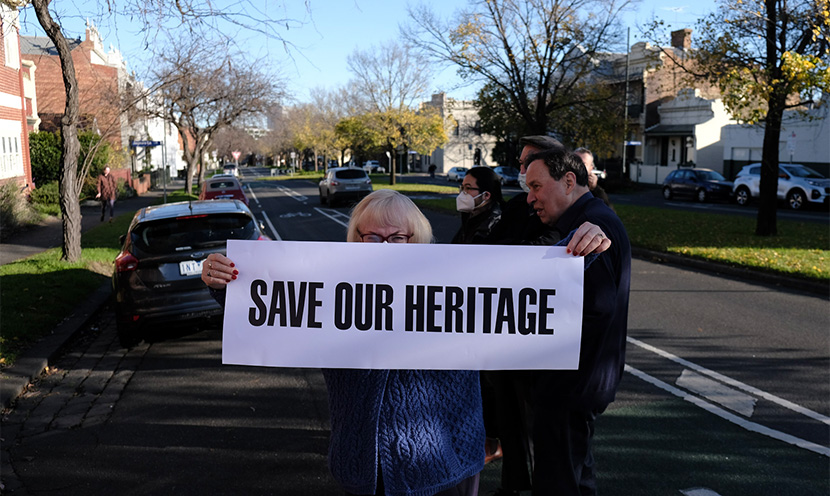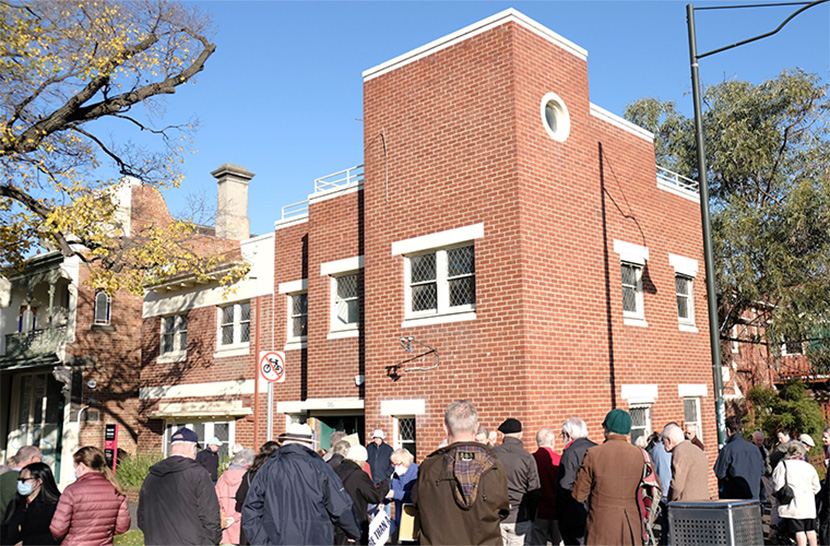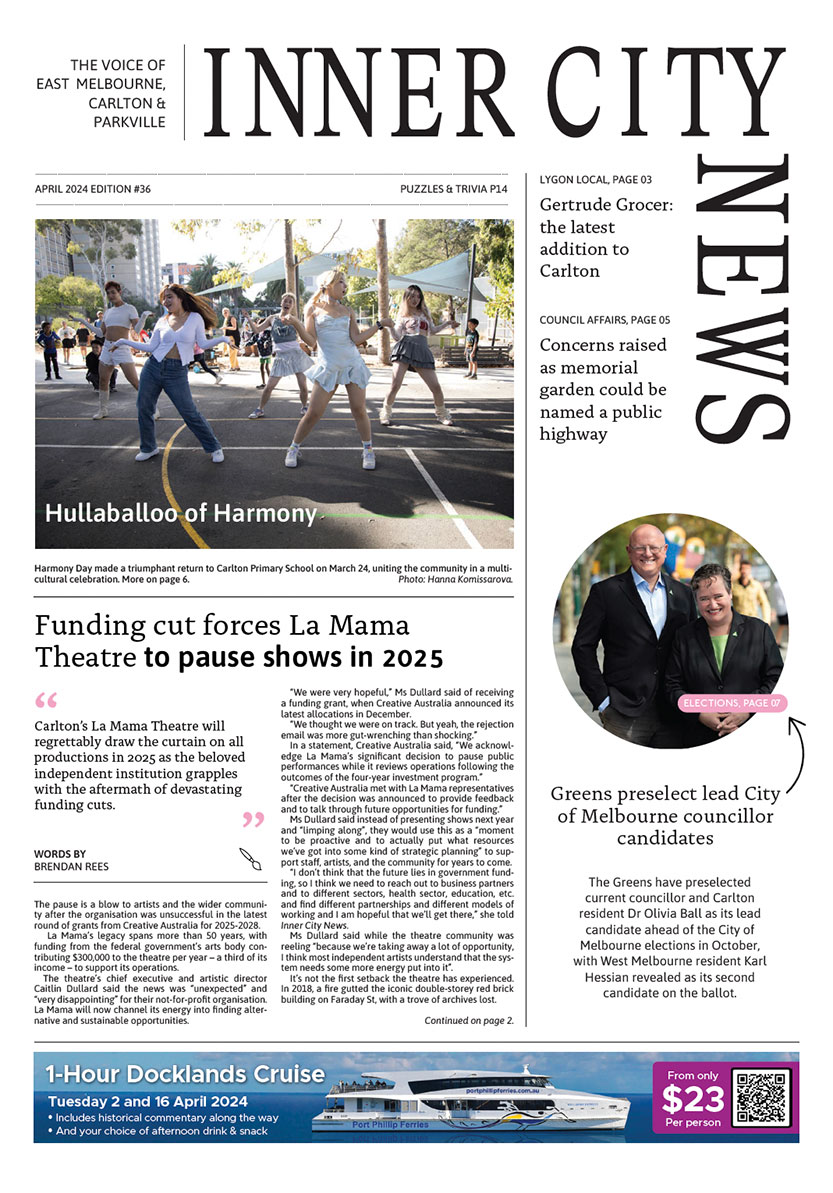“More than a façade”: residents rally to protect Parkville’s heritage
By Carol Saffer & Sean Car
At the time of publishing, the City of Melbourne had already received more than 140 objections from Parkville residents who have united against a proposal to demolish one of the few remaining historic commercial properties in their heritage precinct.
Around 50 local residents rallied on Saturday, June 25 in front of Hartcourt – an intra-war red brick building on the corner of Royal Parade and Morrah St, which is now the subject of an application for a new medical centre.
The building’s owner Sinclair Dermatology submitted amended plans to the council in March for a three-storey clinic with basement level car parking accessible via Jaguers Lane, with the facility expected to employ 37 full-time staff and treat more than 150 patients daily.
But in addition to the unwanted strain residents say the proposal will have on parking and congestion in the area, it’s the applicant’s plans to demolish the building, while only retaining the façade on Royal Parade that has locals up in arms.
Led by the Parkville Association on June 25, locals demonstrated out the front of Hartcourt with signs stating, “more than a façade”, “save our heritage” and “no development or need for a medical centre in our heritage suburb.”
Among the protestors was Parkville resident and Nobel Laureate Professor Peter Doherty, who told Inner City News that when it came to protecting Melbourne’s heritage “continuity matters … protect our heritage!”
Listed as a heritage precinct under the Melbourne Planning Scheme, the Parkville Precinct is considered of “state significance”, while South Parkville, where Hartcourt is located, is considered an example of “particularly intact Victorian residential development.”
It’s for these reasons Parkville residents are pleased with the status quo of heritage fabric in their suburb, with Hartcourt considered one of just four commercial properties in South Parkville along with the post office, Naughtons Hotel and Café Piccolina.
Parkville Association president Robert Moore has called on residents to express their feelings in opposition to the planning application, declaring “facadism clearly does not replace the heritage of this great example of 1920s architecture.”
But the City of Melbourne is likely to face a challenging decision when the matter does eventually come before councillors, as despite being in a heritage precinct along the “significant streetscape” of Royal Parade, the building itself has no heritage protection.
While residents hope that a heritage review of Parkville, expected to be finalised by October, could see Hartcourt mentioned in the precinct’s heritage overlay, it by no means guarantees the building’s protection from demolition.
Sinclair Dermatology’s decision to retain Hartcourt’s façade voluntarily could be looked at favourably by the council in the absence of any heritage protections, but residents are fighting to save the building from any demolition whatsoever.
A Parkville resident and technical transport expert argued in her objection that the development did not comply with specific aspects of state planning regulations, nor the City of Melbourne’s strategic objectives, stating “it does not serve a local community purpose.”
“As a specialist commercial facility, it will generate a broad demand for its services, which will have a significant detrimental impact on local amenity due to the associated vehicle traffic and demand for on-street parking,” she said.
In raising issue with the number of patient trips forecast as a result of the number of practitioners employed at the medical centre, she argued there was no recognition in the plans for employee’s travel behaviour.
“This application does not present an adequate travel demand management strategy [for non-residential uses] and would be unable to develop one due to its business size and the travel behaviours of its client (patient) base,” she said.
“For unfamiliar or occasional trips, people rely on a familiar travel mode that gives them confidence and minimises travel time.”
“In Melbourne, this is driving, especially for trips over long distances, as the total travel time for public transport is far greater than car travel.”
But while Hartcourt’s lack of heritage protection presents the community with a challenging fight, Mr Moore is hopeful that Parkville’s “strict heritage overlay” as “the first heritage-listed suburb in Australia”, will be enough for the council to oppose the proposal.
Concerned that an approval could establish a concerning precedent for other sites in the precinct, he stressed that no buildings had been demolished in Parkville in the past 25 to 35 years.
“[As president] I briefed a barrister who specialises in this area, and the Parkville Association have now retained her to act on our behalf,” he said.
“If this development gets through, then the bio-medical precinct will have their eyes on other developments, and we are back to where we started in 1968.”
Hartcourt has a long history with education having been previously occupied by the University of Melbourne’s Faculty of Applied Science, while its most recent owner was Trinity College.
Mr Moore said that the Parkville Association had successfully campaigned against plans by the college in 2018 to demolish the building, which is ultimately withdrew following community pressure.
Sinclair Dermatology lodged its initial planning application for the Hartcourt building to the City of Melbourne in December 2021, to which the council requested amendments.
In March, amended plans were submitted with a setback to the top floor. According to the application, the proposal’s height of around 10.5 metres falls within the required limit for the building’s commercial status in the precinct.
Sinclair Dermatology was contacted for comment by Inner City News.
Photography by Rachel Litwin

Carlton language school championed by Ukrainian refugee





 Download the Latest Edition
Download the Latest Edition